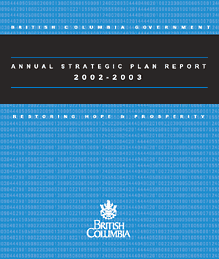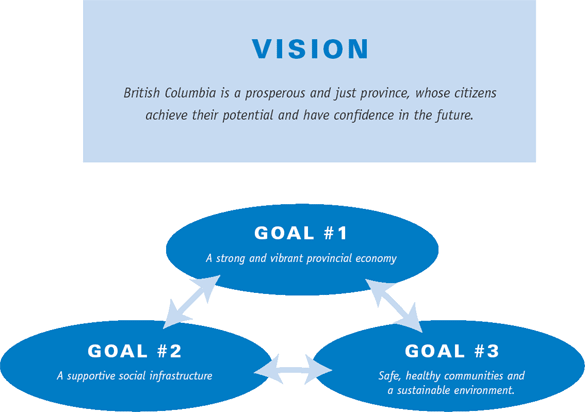 |
|
Note from the Premier
Annual reports are an important means of ensuring progress and accountability for honouring our commitments. They not only demonstrate where progress is being made, but also identify areas where improvement is needed. As this report shows, much has been achieved in the past 12 months. To revitalize our economy, we have implemented 27 tax relief measures, providing a total of over $900 million in net tax relief to individuals, and $350 million in net tax relief to business. We have removed over 50,000 regulatory requirements, eliminated the backlog in Crown land applications and streamlined land use approvals. As a result of these and other actions, British Columbia created 78,000 new jobs in 2002. We led the country in growth in average weekly wages. We led the country in growth in wholesale sales. Mineral exploration was up by 25%, housing starts increased by 25%, and our provincial economy grew by three times the original forecast. To restore sound fiscal management, we have implemented a rigorous new budget planning process, including three-year Ministry service plans and new accountability measures. As a result, for the first time in over 50 years, every Ministry was on or under budget in 2002/03, and British Columbia is on track to balance the budget in 2004/05. To patients and students first, we have made substantial investments in health and education, and comprehensive reforms to ensure every dollar is spent where it’s needed. We have added $1.4 billion in health spending. We are increasing training spaces for doctors, nurses and health professionals. We have added resources for schools, and over the next three years will increase annual education funding by $143 million. All of these measures are resulting in significant improvements to our economy, our public services and British Columbians’ quality of life. At the same time, it’s important to note that the plan we are following will take time to fully implement. This report lays out 25 specific measures that provide a summary of our strategic goals, and our province’s long-term progress toward meeting each. In some cases, the most recent data available is for time periods prior to 2002/03, and does not reflect changes made in the past 12 months. We will continue implementing our plan in the year ahead, and honouring our commitments to revitalize the economy, open up new jobs and investment, and renew our public services. We will continue to build on the progress made so far, and work with British Columbians to achieve continued improvements. The result will be new economic opportunities, renewed services, and a bright future for all of us. Gordon Campbell IntroductionThis is the second Annual Report of the Government of British Columbia and the first report covering a full fiscal year under the British Columbia Liberal government. With this second report, the government is seeking a transformation of the relationship between British Columbians and their government. This Annual Report is part of a process in which the government will become increasingly accountable to its citizens by focussing on results for all of its activities. Of course, as always, the challenge is to meet our operational and development goals while keeping our financial position sound and stable. Our key policy priorities recognize that good economic management is not an end in itself, but is a mechanism to allow British Columbia’s families to prosper. This Annual Report identifies areas where British Columbia is performing well. For example, British Columbians are amongst the healthiest and most highly educated in Canada. The document also identifies opportunities for improvement, as well as actions the Government is taking to address those issues. Performance ReportingThe Government of British Columbia is dedicated to ensuring that the services it provides to British Columbians are well managed, and are consistent with its priorities. A critical part of government accountability is the requirement to publish regular, informative reports. The Balanced Budget and Ministerial Accountability Act requires that each ministry prepare a three-year service plan outlining its priority initiatives, performance targets and performance measures. Provisions of this Act also require government and Ministers to table annual reports by August 31 each year that compare actual results against the Government’s Three Year Strategic Plan and Ministry Three Year Service Plans. This second Annual Report compares the government’s performance against the performance measures and strategic actions outlined in the British Columbia Government 2002/03 - 2004/05 Strategic Plan. In order to ensure that British Columbians can confirm the results of our performance, we have used several reliable sources to obtain data for these measures: Statistics Canada, B.C. Stats, Ministries, and the B.C. Progress Board. This report is a prototype that will be developed and refined in future years. The Government of British Columbia’s 2003/04 - 2005/06 Strategic Plan has been strengthened significantly from the initial Strategic Plan that we are reporting on in this Annual Report. We have made a conscious effort to ensure the Government’s Annual Report is a user-friendly document that meets the needs of our citizens and fulfills this government’s commitment to transparency and accountability. Evaluation in this report is undertaken on a “whole of government” basis, although individual Ministries are responsible for reporting on specific outputs of the Ministry. The Government’s Annual Report is the umbrella for individual Ministry reports, which are being published in tandem with this document. Timeliness of MeasuresMeasuring progress can be challenging for a variety of reasons. First, current data is not always available in each performance category. For some of the 25 performance measures in this report, the most recent data available is for time periods prior to the 2002/03 fiscal year, and does not reflect progress made in the past 12 months. Second, some goals may take several years to accomplish, while others may be affected by national and global events. Nevertheless, it is important to set benchmarks for future progress. On balance, government is making significant progress in achieving its goals and objectives. Selection of MeasuresThe performance measures reported on in this report fall into three categories: Output/Workload Indicators Outcome/Effectiveness Indicators Efficiency/Cost-Effectiveness Indicators Progress Report
on
|
|||||

 It
is my privilege to present the second Annual Report of the Government
of British Columbia. Last year we published the first British
Columbia Government Strategic Plan 2002/03 - 2004/05. It outlined
our policy priorities and the actions we will undertake. This
Annual Report sets out our progress in achieving those goals.
It
is my privilege to present the second Annual Report of the Government
of British Columbia. Last year we published the first British
Columbia Government Strategic Plan 2002/03 - 2004/05. It outlined
our policy priorities and the actions we will undertake. This
Annual Report sets out our progress in achieving those goals.
